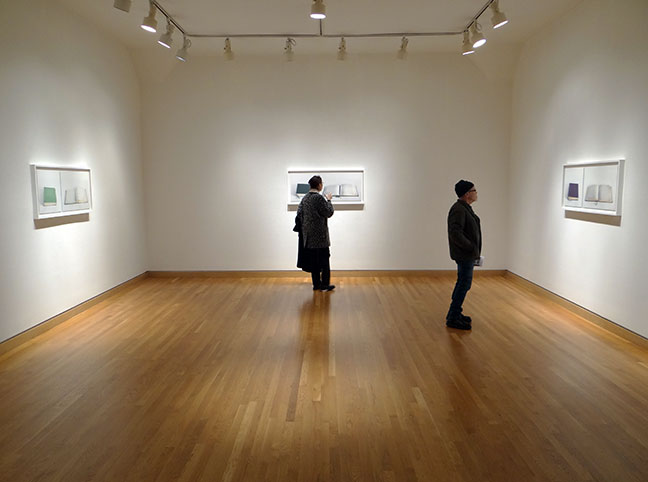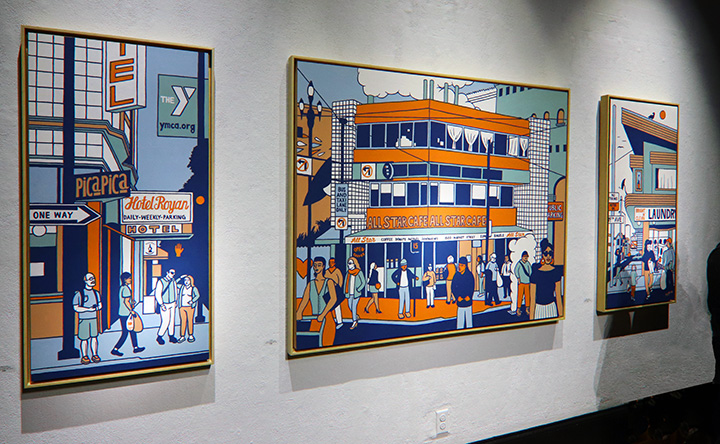Your Artist Statement:
Explaining the Unexplainable
Q: Why do I have to write an artist statement? It's stupid. If I wanted to write to express myself I would have been a writer. The whole idea of my art is to say things visually. Why can't people just look at my art and take away whatever experiences they will?
A: Artist statements are not stupid; they're more like essential. The good news is that learning how to write an artist statement is easier than you think. And you don't have to be a writer to write one. And people already look at your art and take away whatever experiences they will. Your artist statement is about facts, a basic introduction to your art; it's not instructions on what to look at, how to look at it, what to experience, what to think, how to feel, how to act, or where to stand, and if it is, you'd better do a rewrite.
No matter what the circumstances, people communicate with words. That's just the way things are. And your artist statement introduces and communicates the language component of your art. People who come into contact with your art for the first time and want to know more will often have questions. When you're there, they ask you and you answer. When you're not there, your artist statement answers for you.
Or when you are there, but you don't feel like answering questions, or you're too busy to answer questions, or someone's too embarrassed to ask you questions, or you're too embarrassed to answer questions, then your pal-- your artist statement-- does that job for you. And let's not forget the Internet. Thanks to the Internet, more people than ever before are looking at art, particularly on social media. In other words, your potential audience and fan base is huge. So on behalf of anyone who sees your art for the first time and may want to know more, let's get busy and write the thing...
Just about all artists want as many people as possible to appreciate their art. A good artist statement works towards this end, and the most important ingredient of a good statement is its language. WRITE YOUR STATEMENT IN LANGUAGE THAT ANYONE CAN UNDERSTAND, not language that you understand, not language that you and your art friends understand, not language that you learn in art school, but everyday language that you use with everyday people to communicate about everyday things.
Why everyday language? Because the very large majority of people who look at and appreciate art do not have art educations and can't understand art jargon. Artspeak only confuses them, and when someone gets confused, they usually leave you and go somewhere else to see art that they can understand.
An effective statement reaches out and welcomes people to your art, no matter how little or how much they know about art to begin with; it never excludes. Rest assured that those who read your statement and want to know more will provide you with ample opportunities to go into greater detail-- LATER, NOT NOW.
Like an introduction to a good book, your statement presents and conveys the fundamental underpinnings of your art, aspects that people should be aware of. Write it for people who like what they see and want to know more, not those who already know you and know everything your art is about.
In one to three paragraphs of three to four sentences each (150-250 words), provide basic information like WHY YOU MAKE YOUR ART, WHAT INSPIRES YOU TO MAKE IT, WHY PEOPLE SHOULD CARE, WHAT IT SIGNIFIES OR REPRESENTS, WHAT IT COMMUNICATES, WHAT'S UNIQUE OR SPECIAL ABOUT IT, or even WHAT IT MEANS TO YOU. Whatever you want them to know.
Don't bog readers down, but rather entice them to want to know more. As with any good first impression, your statement should hook, entice, and invite further inquiry, like a really good story is about to unfold. Give too little, not too much.
Most people have short attention spans, especially these days, and extra especially online where most of them now go to look at and read about art. When you overload readers with details or complicated explanations, you risk drowning them in words, and possibly even discouraging those who might otherwise persevere if only it was more basic and straightforward. It can be as basic as you talking about or answering commonly asked questions about your art, for example.
Save deeper or more complicated essay answers for those who progress to the next level and want to know more. Don't worry about having to satisfy your longtime dedicated fans. You won't bore them and you won't lose them; they already love you. And if they have questions, they know how to contact you and get them answered.
Remember-- your statement is about expanding your audience, about welcoming NEW people to your work, not limiting your audience to those you already know. You'll have plenty of time to give these new fans and followers the grand tour-- LATER, NOT NOW. Because in order to progress to that stage, you have to engage and entice them first.
Plus this... your statement is about you, so personalize it. Write it in the first person (I, me, my, etc), not in the third person (he, she, they, them, their, etc). Infuse it with your own unique perspective. Whenever possible, make it conversational, like you're speaking directly to readers (note: a good editor can work wonders here). And please oh please keep it simple.
The more complicated or impersonal it is, the more trouble people will have trying to hack through it and connect with you and your art in meaningful ways. Few readers want to burn calories trying to decipher complex text. For now, get a basic sense of what your art is about, spend some time looking, experience its essence, have fun, and enjoy themselves.

Summary and additional tips:
* Not all artists can write well. If you're in that category, think seriously about hiring a professional writer or editor to write for you, preferably one with an art background, to help you say what you want your statement to convey in language that ordinary everyday people can understand.
* Make "I" statements rather than "you" statements. Talk about what your art does for you, not what it's supposed to do for the viewers. This doesn't mean you start every sentence with "I," but rather that you respect people's autonomy and allow them to respond to your art however they wish.
* At all times, give readers the option to agree or disagree with you. Never pressure them or attempt to dictate outcomes. Your statement begins the narrative, your viewers take it from there.
* Avoid third-party quotes about your art made by other people such as gallery owners, critics, collectors, or curators. These belong in your bio, resume, CV, or lists of reviews or publications that include your work. Your statement should be just you talking to your viewers.
* Connect what your art expresses with the medium you're expressing it in. For example, if your art is about world peace, and it consists of twigs protruding from pieces of clay, briefly explain the connection. Arbitrarily stating that twig/clay protrusions represent world peace leaves people wondering. If of course, the object of your art or your statement is to leave people wondering, then that's OK. In art everything is OK, but in order to succeed as an artist, someone beside yourself generally has to get the point of what you're doing and why you're doing it.
* Be specific, not vague. For example, if your art is "inspired by assessments of the fundamentals of the natural world," tell which fundamentals you're assessing and how they inspire you.
* Avoid obscure references to music, art, literature, history, or anything else that requires detailed explanations, research, or gobs of previous knowledge. If you have to make such a reference, explain it fast so people can get a quick grip and move on. Better yet, instead of a reference, say the same basic thing in your own words. If you can't do it fast, save it for later.
* Tell the story about what led up to your art ONLY if it's short (no more than two or three sentences), compelling, and really really relevant. People are generally not interested in progressions of antecedent events. Something leads up to everything; we all know that. Unless something in your past is integral to understanding your art in the present, leave it for later. Or put it in your bio.
* Avoid comparing yourself to other artists. If other artists influence you, fine, but don't say, "Like Picasso, I do this" or "Like Judd, I do that." Best to leave them out of your statement altogether. Let the critics decide who you're like. Plus you don't want to invite comparisons between yourself and the greatest artists who've ever lived. We all know who's going to win those battles.
* Avoid instructing people on how to see, feel, behave, respond, or otherwise relate to your art. Nobody likes being told what to do. Instead of saying "You will experience angst when you see my art," say "This art expresses my angst" or "I express my angst through my art."
***
Before you go public with your statement, get feedback. Show your art and statement to friends, friends of friends, and maybe even a stranger or two. Make sure they get what you're saying and come away understanding what you would like them to understand. When they don't, or you have to explain yourself, do a rewrite and eliminate the confusion. If you need help, find someone who writes or edits and have them fix the problem. Many times, a little rearranging is all that's necessary to make your statement a clean clear concise read.
No matter how superb or intriguing your statement is, know up front that most people will read it quickly and move on; only a few will want to know more, fewer yet will want to know everything, and fewer yet will ultimately progress to the point where they actually buy a piece of your art. That's simply the nature of art and personal taste. And it's also perfectly OK because the whole point is getting them to look at your art.
And last but certainly not least, never underestimate the power of an effective statement to intensify, enhance, and deepen how people connect, experience, and identify with your art.
***
Need help writing, editing, revising or expanding your artist statement? I write for artists all the time-- statements, essays, explanations, descriptions, whatever you need. Call 415.931.7875 or email alanbamberger@me.com.
To learn more about the value of good art writing, go here >>

(art by Emily Fromm)

Current Features
- How to Buy Art on Instagram and Facebook
More and more people are buying more and more art online all the time, not only from artist websites or online stores, but perhaps even more so, on social media ... - Collect Art Like a Pro
In order to collect art intelligently, you have to master two basic skills. The first is being able to... - San Francisco Art Galleries >>


